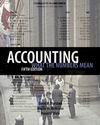 |  Accounting: What the Numbers Mean, 5/e David H. Marshall,
Millikin University
Wayne W. McManus,
International College of the Cayman Islands
Daniel F. Viele,
Webster University
Accounting for and Presentation of Current Assets
Chapter 5 Learning ObjectivesAfter studying this chapter, you should understand:
1.What is included in the cash and cash equivalents amount reported on the balance sheet. |
 |  |  | 2.The features of a system of internal control and why internal controls are important. |
 |  |  | 3.The bank reconciliation procedure. |
 |  |  | 4.How short-term marketable securities are reported on the balance sheet. |
 |  |  | 5.How accounts receivable are reported on the balance sheet, including the valuation allowances for estimated uncollectible accounts and estimated cash discounts. |
 |  |  | 6.How notes receivable and related accrued interest are reported on the balance sheet. |
 |  |  | 7.How inventories are reported on the balance sheet. |
 |  |  | 8.The alternative inventory cost-flow assumptions and their respective effects on the income statement and balance sheet when price levels are changing. |
 |  |  | 9.The impact of inventory errors on the balance sheet and income statement. |
 |  |  | 10.What prepaid expenses are and how they are reported on the balance sheet. |
|


 2002 McGraw-Hill Higher Education
2002 McGraw-Hill Higher Education